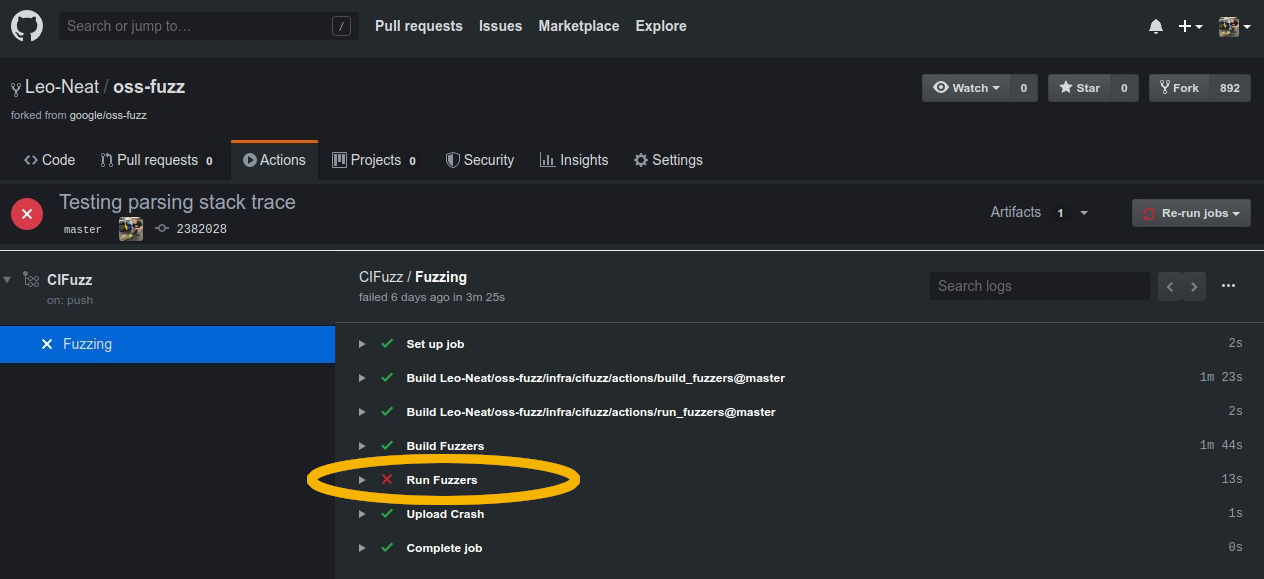4.0 KiB
| layout | title | parent | nav_order | permalink |
|---|---|---|---|---|
| default | Continuous Integration | Getting started | 5 | /getting-started/continuous-integration/ |
Continuous Integration
OSS-Fuzz offers CIFuzz, which will run your fuzz targets each time a pull request is submitted, for projects hosted on GitHub. This allows you to detect and fix bugs before they make it into your codebase
How it works
CIFuzz works by checking out a repository at the head of a pull request. The project's fuzz targets are built and run for a definite amount of time (default is 10 minutes). If a bug is found, the stack trace as well as the test case are made abailable for download. If a crash is not found the test passes with a green check.
Requirements
- Your project must be integrated in OSS-Fuzz.
- Your project is hosted on GitHub.
Integrating into your repository
You can integrate CIFuzz into your project using the following steps:
- Create a
.githubdirectory in the root of your project. - Create a
workflowsdirectory inside of your.githubdirectory. - Copy the example
main.ymlfile over from the OSS-Fuzz repository to theworkflowsdirectory. - Change the
project-namevalue inmain.ymlfromexampleto the name of your OSS-Fuzz project. It is very important that you use your OSS-Fuzz project name which is case sensitive. This name is the name of your project's subdirectory in theprojectsdirectory of OSS-Fuzz.
Your directory structure should look like the following:
project
|___ .github
| |____ workflows
| |____ main.yml
|___ other-files
main.yml for an example project:
name: CIFuzz
on: [pull_request]
jobs:
Fuzzing:
runs-on: ubuntu-latest
steps:
- name: Build Fuzzers
uses: google/oss-fuzz/infra/cifuzz/actions/build_fuzzers@master
with:
project-name: 'example'
dry-run: false
- name: Run Fuzzers
uses: google/oss-fuzz/infra/cifuzz/actions/run_fuzzers@master
with:
fuzz-time: 600
dry-run: false
- name: Upload Crash
uses: actions/upload-artifact@v1
if: failure()
with:
name: artifacts
path: ./out/artifacts
Optional configuration
fuzz-time: Determines how long CIFuzz spends fuzzing your project in seconds.
The default is 600 seconds. The GitHub Actions max run time is 21600 seconds (6 hours).
dry-run: Determines if CIFuzz surfaces errors. The default value is false. When set to true,
CIFuzz will never report a failure even if it finds a crash in your project.
This requires the user to manually check the logs for detected bugs. If dry run mode is desired,
make sure to set the dry-run parameters in both the Build Fuzzers and Run Fuzzers action step.
Understanding results
The results of CIFuzz can be found in two different places.
- Run fuzzers log:
- This log can be accessed in the
actionstab of a CIFuzz integrated repo. - Click on the
CIFuzzbutton in the workflow selector on the left hand side. - Click on the event triggered by your desired pull request.
- Click the
Fuzzingworkflow. - Select the
Run Fuzzerdrop down. It should show the timestamps and results from each of the fuzz targets.
- This log can be accessed in the
- Artifacts:
- When a crash is found by CIFuzz the Upload Artifact event is triggered.
- This will cause a pop up in the right hand corner, allowing
you to download a zip file called
artifacts. artifactscontains two files:test_case- a test case that can be used to reproduce the crash.bug_summary- the stack trace and summary of the crash.
Feedback/Questions/Issues
Create an issue in OSS-Fuzz if you have questions of any other feedback on CIFuzz.

